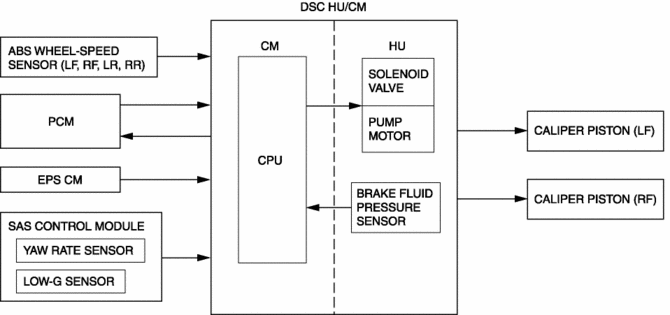Mazda CX-5 Service & Repair Manual: Tcs Control
Outline
-
The TCS control actuates torque reduction through engine control, as well as using brake control to control traction.
NOTE:
-
Engine control: Engine output is lowered by fuel cut and ignition timing control to reduce the traction, preventing driving wheel slip.
-
Brake control: Brake fluid pressure from the hydraulic unit (HU) to the driving wheel that is slipping is increased, operating the brake and preventing driving wheel slip.
Features
-
The left and right wheels are controlled at the same time by engine control. Therefore, when the road surface friction coefficients differ between the left and right wheels, proper torque reduction cannot be performed separately for each wheel. When this occurs, torque reduction is performed by independent left and right wheel brake control, providing more stable vehicle control.
-
The TCS OFF switch allows the driver to optionally enable/disable the TCS control at the driver's discretion.
-
When both driving wheels are stuck, traction control according to the driver's operation can be performed by inhibiting the TCS control.
-
The TCS control returns to normal operation automatically at the next ignition cycle.
Construction
Block Diagram

Operation
-
TCS control detects driving wheel spin based on the signals listed below, sends torque reduction request signals to the PCM, and also controls the solenoid valves and pump motor in the DSC HU/CM.
-
Vehicle wheel speed signals from the font and rear ABS wheel-speed sensors
-
Engine torque signal from the PCM
-
Steering angle signal from the EPS CM
-
Yaw rate and lateral-G signals from the SAS control module
-
Fluid pressure signal from the brake fluid pressure sensor (built into the DSC HU/CM)
 Precaution [Dynamic Stability Control (DSC)]
Precaution [Dynamic Stability Control (DSC)]
1. The ABS warning light and/or brake system warning light and/or TCS/DSC indicator
light and/or TCS OFF indicator light illuminate even when the system is normal.
Warning ...
 Tcs Off Switch Inspection
Tcs Off Switch Inspection
1. Remove the TCS OFF switch..
2. Verify that the resistance between the TCS OFF switch terminals B and C is
as indicated in the table.
If not as indicated in the table, replace the TCS OF ...
Other materials:
Awd Control Module Removal/Installation
CAUTION:
When performing configuration, it is necessary to read the coupling component
calibration data from the AWD control module before replacing it. Connect the
M-MDS to the vehicle and perform vehicle identification before removing the
AWD control module. The coupling component ...
Outer Mirror Glass Inspection
Heated Outer Mirror
1. Disconnect the negative battery cable..
2. Remove the outer mirror glass..
3. Verify that the resistance and continuity between the heated outer mirror
terminals is as indicated in the table.
If not as indicated in the table, or if the resistance is not with ...
Hood Release Cable Removal/Installation
1. Disconnect the negative battery cable..
2. Remove the following parts:
a. Front bumper.
b. Front combination light (LH).
c. Front mudguard (LH).
d. Hood release lever.
3. Disconnect the hood release cable from the hood latch.
4. While pressing the tabs of the clip in the direction o ...
